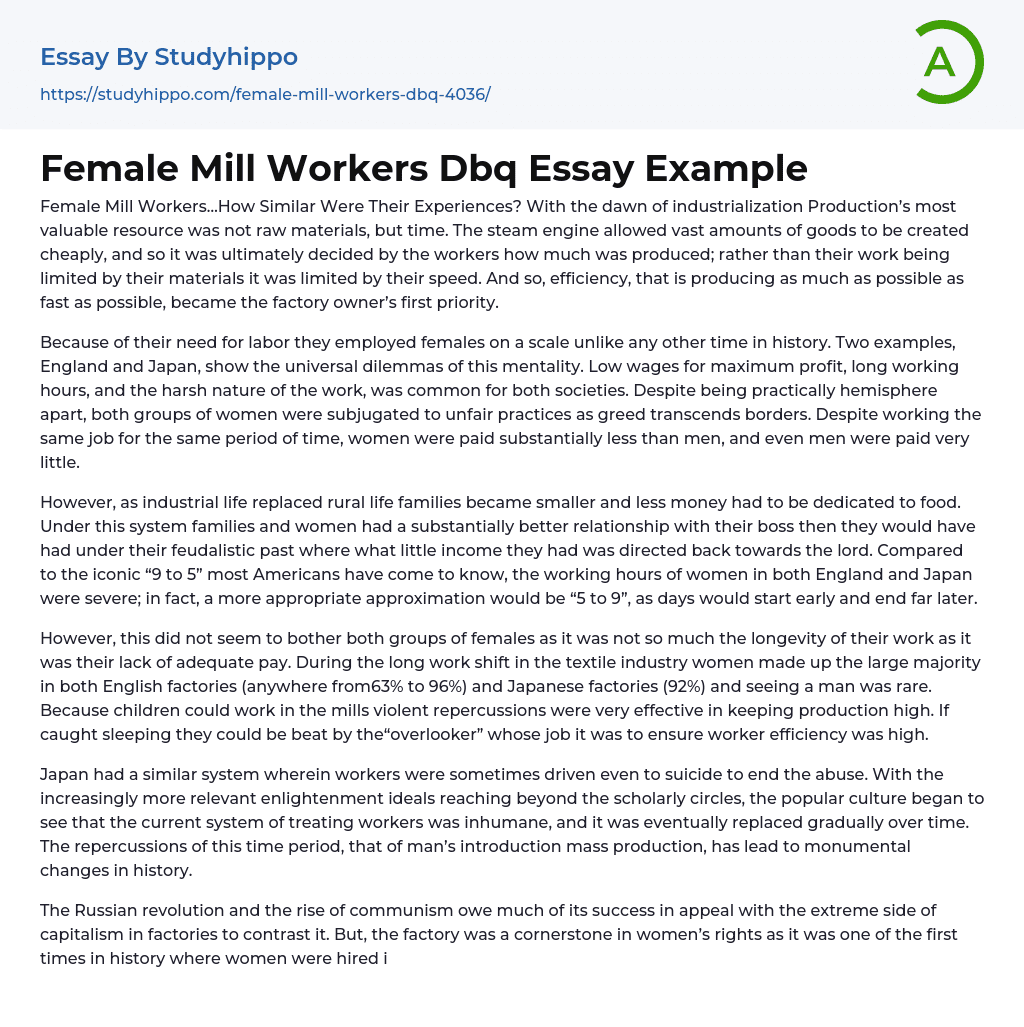Female Mill Workers…How Similar Were Their Experiences? With the dawn of industrialization Production’s most valuable resource was not raw materials, but time. The steam engine allowed vast amounts of goods to be created cheaply, and so it was ultimately decided by the workers how much was produced; rather than their work being limited by their materials it was limited by their speed. And so, efficiency, that is producing as much as possible as fast as possible, became the factory owner’s first priority.
Because of their need for labor they employed females on a scale unlike any other time in history. Two examples, England and Japan, show the universal dilemmas of this mentality. Low wages for maximum profit, long working hours, and the harsh nature of the work, was common for both societies. Despite being practically hemisp
...here apart, both groups of women were subjugated to unfair practices as greed transcends borders. Despite working the same job for the same period of time, women were paid substantially less than men, and even men were paid very little.
However, as industrial life replaced rural life families became smaller and less money had to be dedicated to food. Under this system families and women had a substantially better relationship with their boss then they would have had under their feudalistic past where what little income they had was directed back towards the lord. Compared to the iconic “9 to 5” most Americans have come to know, the working hours of women in both England and Japan were severe; in fact, a more appropriate approximation would be “5 to 9”, as days would start early and end far later.
However, this did not
seem to bother both groups of females as it was not so much the longevity of their work as it was their lack of adequate pay. During the long work shift in the textile industry women made up the large majority in both English factories (anywhere from63% to 96%) and Japanese factories (92%) and seeing a man was rare. Because children could work in the mills violent repercussions were very effective in keeping production high. If caught sleeping they could be beat by the“overlooker” whose job it was to ensure worker efficiency was high.
Japan had a similar system wherein workers were sometimes driven even to suicide to end the abuse. With the increasingly more relevant enlightenment ideals reaching beyond the scholarly circles, the popular culture began to see that the current system of treating workers was inhumane, and it was eventually replaced gradually over time. The repercussions of this time period, that of man’s introduction mass production, has lead to monumental changes in history.
The Russian revolution and the rise of communism owe much of its success in appeal with the extreme side of capitalism in factories to contrast it. But, the factory was a cornerstone in women’s rights as it was one of the first times in history where women were hired in droves, albeit in unpleasant conditions. However, for Japan and England, the horrors of severed fingers and exhaustion were soon replaced by office memos and awkward birthdays.
- Alarm clock essays
- Factory essays
- Material essays
- Production And Manufacturing essays
- Caste System essays
- Citizenship essays
- Civil Society essays
- Community essays
- Culture essays
- Deviance essays
- Discourse Community essays
- Female essays
- Filipino People essays
- Igbo People essays
- Indigenous Australians essays
- Indigenous Peoples essays
- Men essays
- Middle Class essays
- Minority Group essays
- Modern Society essays
- Popularity essays
- Social Control essays
- Social Institution essays
- Social Justice essays
- Social Norms essays
- Social Responsibility essays
- Socialization essays
- The nation essays
- Bangladesh essays
- China essays
- Hong Kong essays
- India essays
- Japan essays
- Kuala Lumpur essays
- Malaysia essays
- Manila essays
- Pakistan essays
- Philippines essays
- Singapore essays
- Vietnam essays
- Vietnamese essays
- Administration essays
- Architect essays
- Discipline essays
- Doctor essays
- Engineer essays
- Farmer essays
- Hunter essays
- Labor essays
- Model essays




